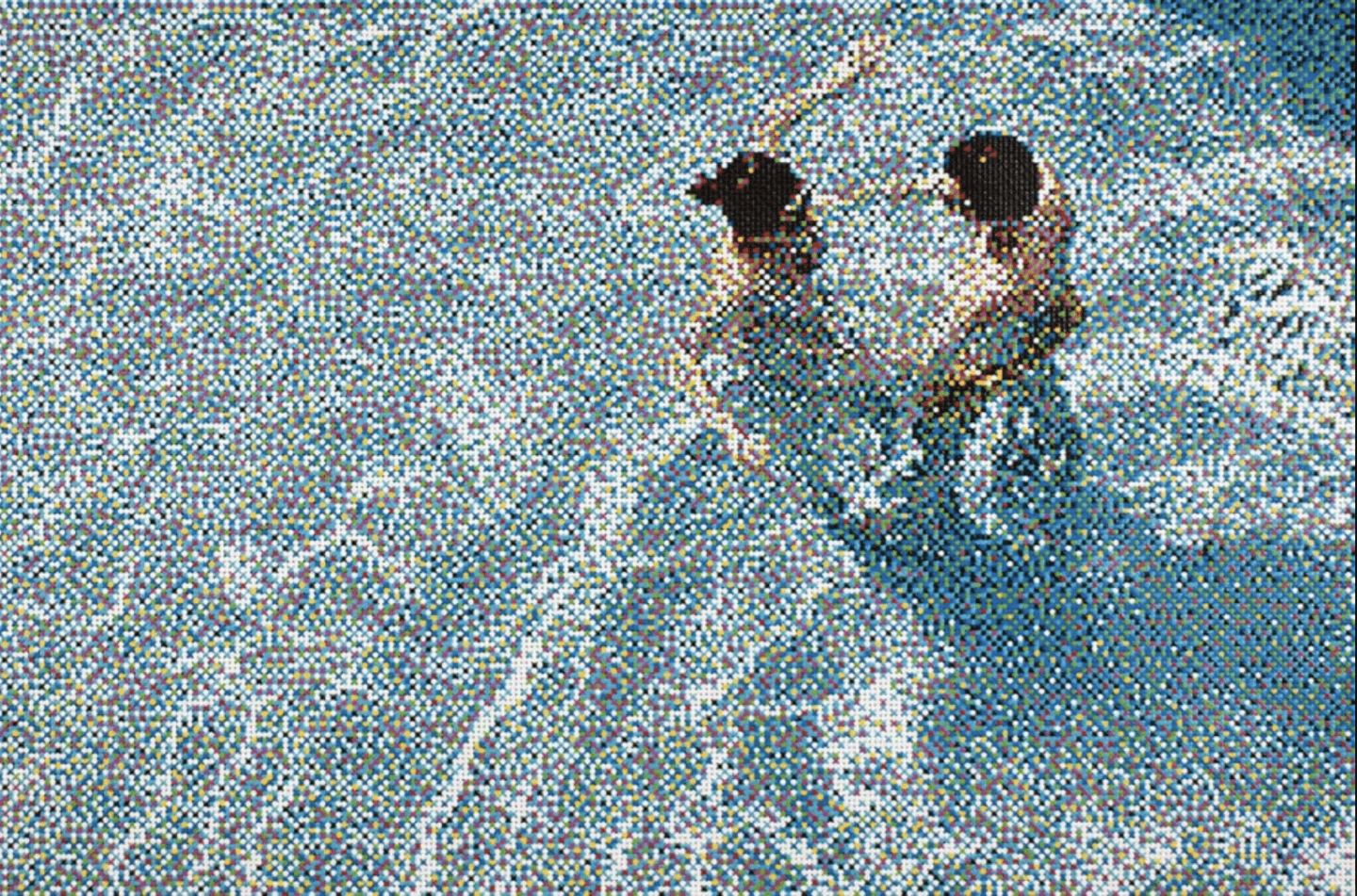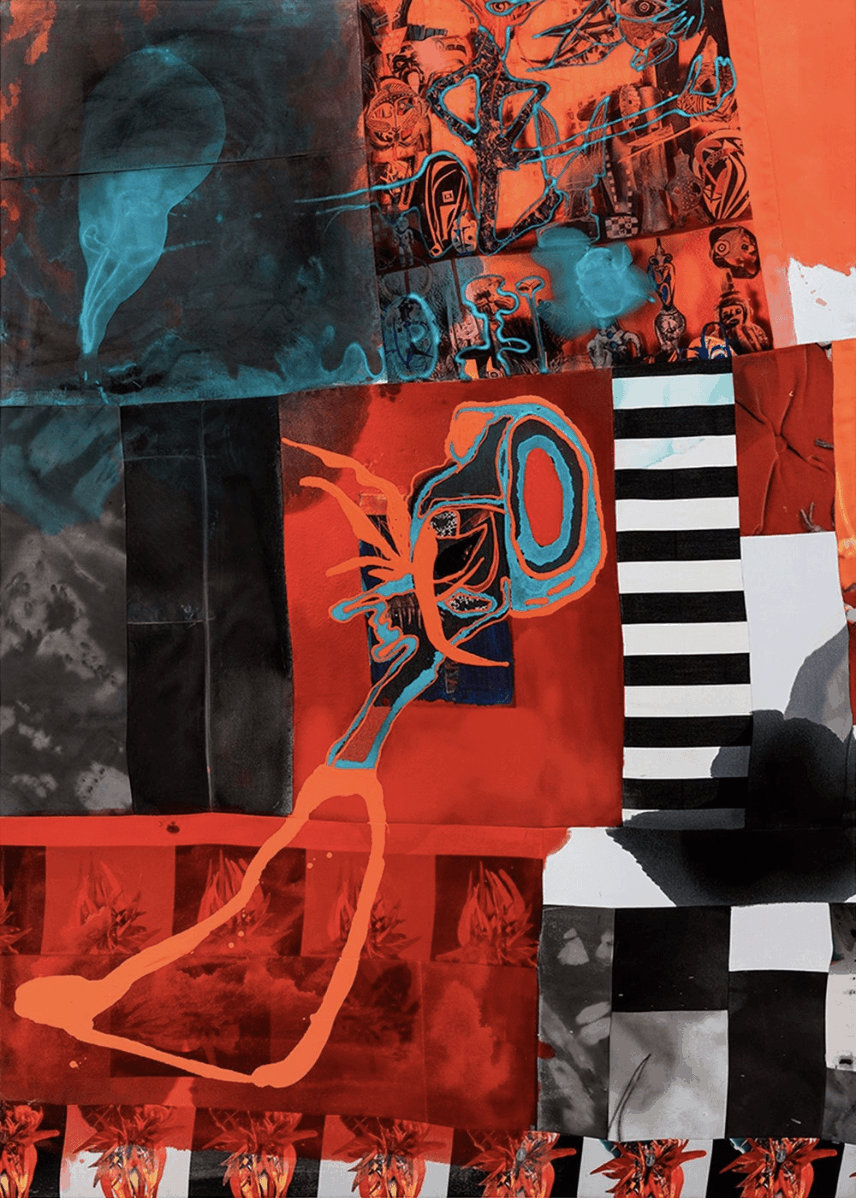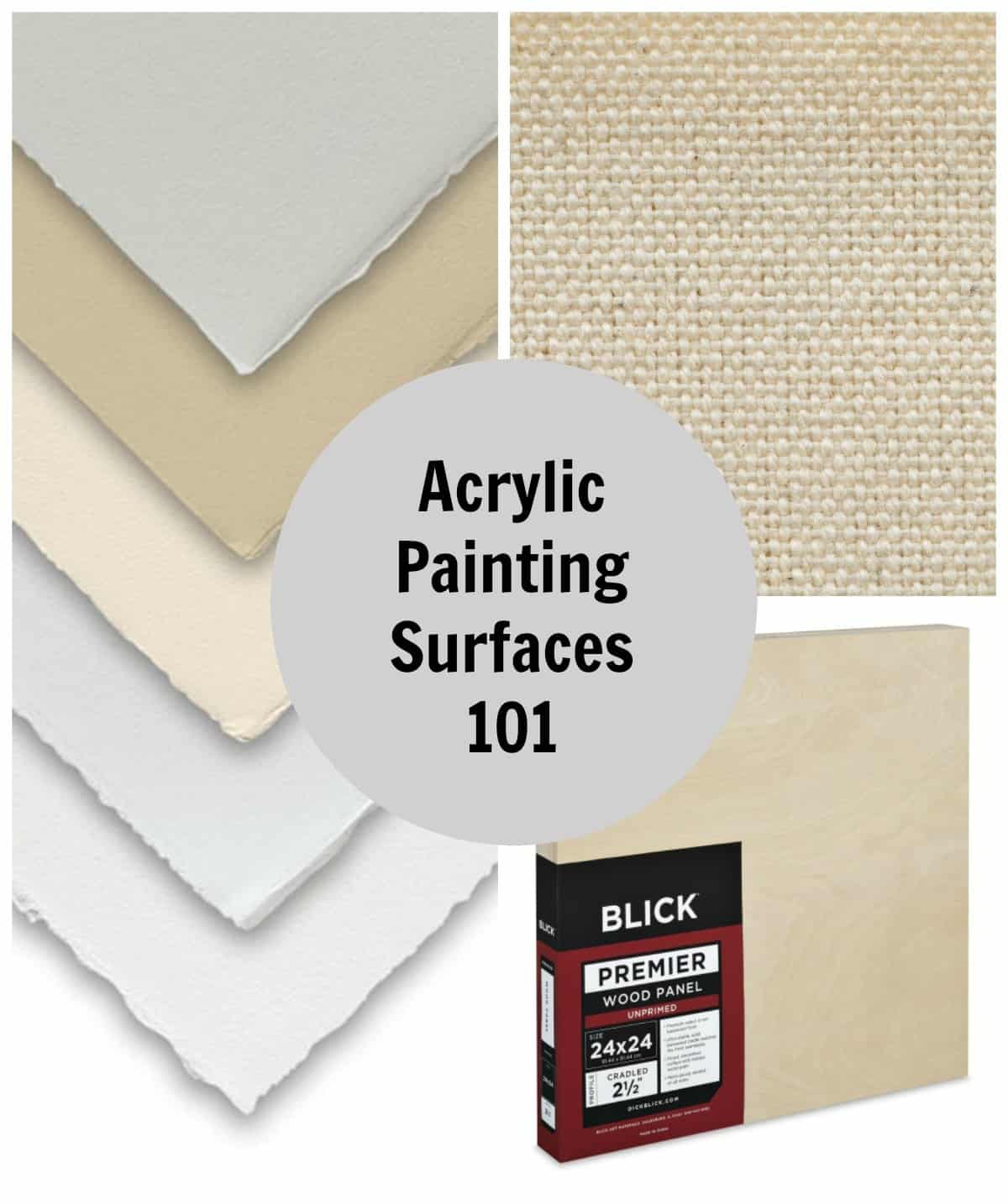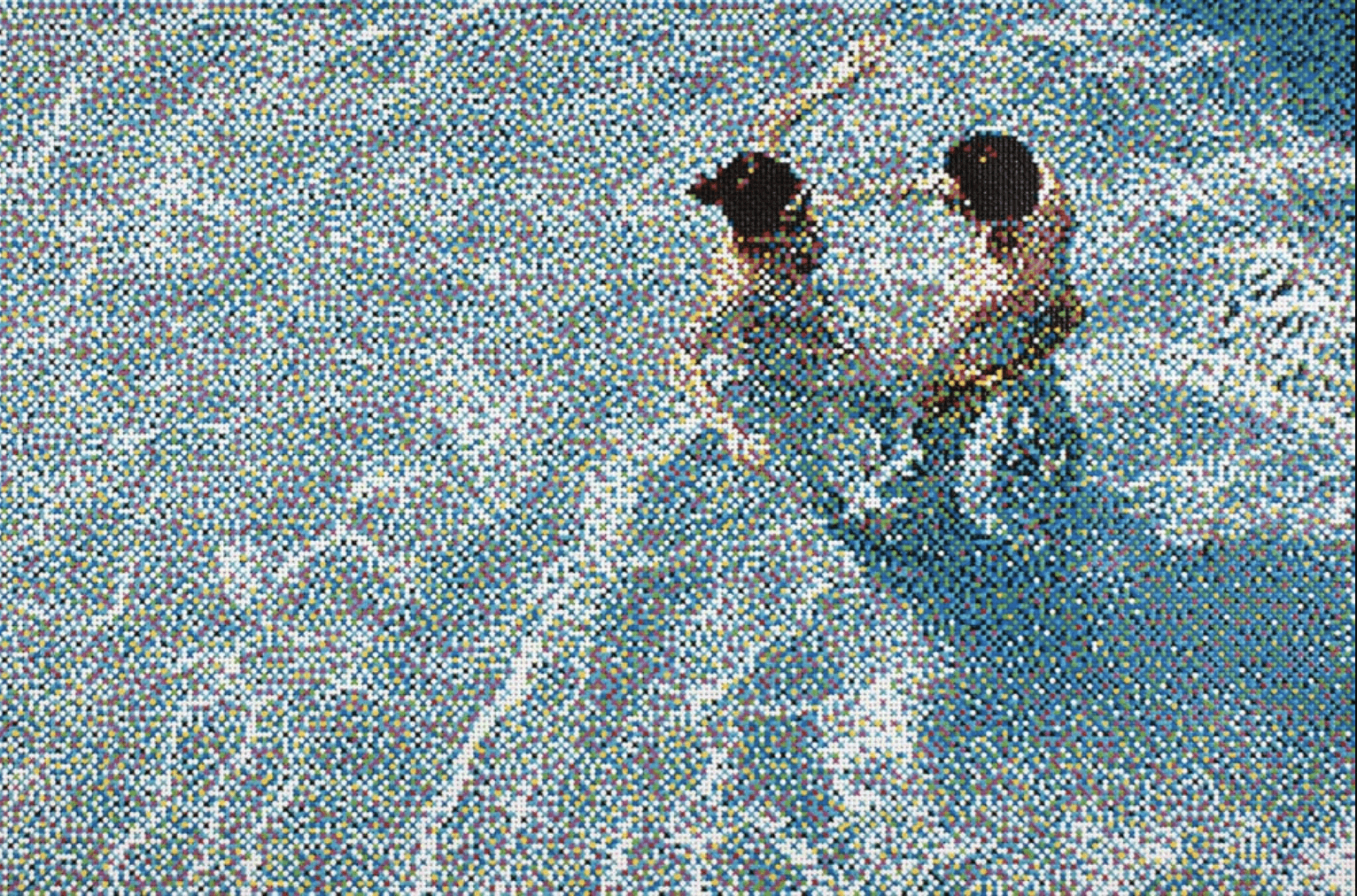I’d like to lead a big raucous cheer right now for acrylic paint, which is not only my favorite art supply, but can also be used on veritably any surface you can think up.
Barring a load of grease or major flaky chips, you can prime any surface that acrylics won’t stick to on their own and paint your little heart out.
In fact, I’ve seen acrylics successfully used on:
- paper
- board
- canvas
- ceramic
- glass
- plastic
- wood
- metal
- fabric
- my arms
Using different surfaces with acrylics can give you vastly varying looks, so if you’ve seen something you’re interested in replicating, or just want to experiment with surface options, keep on reading.
Typical Acrylic Paint Surfaces
These are the substrates most people think of when deciding what to use acrylics on, and are what you will see most acrylic art actually on, so we’ll start with these and then get into the alternative acrylic surfaces.
Canvas
Canvas is the most common painting surface, and you’ll find all sorts of options if you’re looking for canvas to paint on:
- Pre-stretched Primed Canvas
- Pre-stretched Unprimed Canvas
- Unstretched Primed Canvas
- Unstretched Unprimed Canvas
Some artists like the look painting on unprimed canvas gives, as the paint soaks into the clothy surface, but many times you will want to use gesso to seal and prepare the surface first.
Gesso gives a nice white surface that acrylic adheres perfectly to, but isn’t too crazy-absorbent. You can tint it with paint if you want it to have some color, sand it smooth when it’s dry, or brush it on thickly for a textured background.
Another little addition to all the canvas options is the fact that you can choose between cotton and linen canvas to paint on. While cotton is cheaper and lighter, linen is less likely to stretch out of shape and has a texture some artists prefer over cotton. read more about the differences between cotton and linen canvas here.
(I wish I had included this artist in my pointillism post🙂

Wood Panels
These are my Acrylic substrate of choice, as the give and texture of canvas drive me batty. I usually buy them pre-made, although you can certainly make your own.
They come in all sorts of primed and unprimed surfaces, sizes, and depths, and you can hang them by a nail right on the wall, or string eye screws and hanging wire across the back.

More Acrylic Painting Surfaces
Paper
Y’all know I love me some thick printmaking paper for pretty much everything, and acrylics are no exception. Slap a couple of layers of gesso on that stuff and you have a great painting surface. (Play around with it unprimed, too.)
Kraft paper and card stock make interesting paper surfaces to paint on, as do rice papers or parchment. Eric Carle’s famous illustrations are made using acrylics on tissue paper before he collages them.
This painting by Martha Rich is acrylic and cut paper on paper:

Yupo
Okay, I know pretty much zero about Yupo except that it’s slick and non-porous, and people who use it seem to love it. I’ve seen it mentioned as a possible surface for acrylics, so I thought I’d add it on in here in case you want to look into it.
Masonite or MDF
You can buy masonite and mdf pretty inexpensively if you want to test out hard surfaces for acrylic before you invest in the cradled panels. Or you might find you just want to stick with these surfaces.
Both are pressurized mixtures of wood fibers and glues that make up a wood-like surface, and you have seen these in some inexpensive furniture.
Always choose untempered masonite, and gesso the front and back to minimize any warping you might get. You can also make your own cradled panels by cutting 2×4’s to fit the back of your masonite pieces, or buy pre-made gessoed hardboard panels.
And then you can go even further by stretching canvas or linen over the front of the whole thing if you want to get totally fancy. (I haven’t tried this but my friend John made a lot of paintings using this technique.)
Fabric
Acrylic is super duper on fabric. We use it to make cool t-shirts, but you could also stamp some acrylic designs on pillow cases, paint on silk, like scarves, or even paint on shoes.
Acrylic paint is permanent on fabric, but is thick and stiff, so will tend to peel off and fade over time, so you may want to use fabric medium with it.
Fabric medium mixed with acrylic paint makes it more pliable for fabric you are planning to wear or that will be moving around a lot. Try this fabric medium or GAC 900 by Golden.
Remember to put cardboard in between or under fabric to protect other layers and surfaces from the paint.

Glass
When I first started making acrylic paintings out of college, I would scavenge old paneled windows I found on the streets of Chicago, gesso up the glass, and paint on them.
I shiver at the thought of painting on glass now as it’s so damn breakable, but hey ya, knock yourself out if you are feeling the draw of glass as your surface.
Make sure the glass is cleaned really well first, then wipe it off again with rubbing alcohol, and let it dry before priming it.
Also, don’t wear your clown shoes while carrying your paintings on glass or you might trip and fall on them. I don’t know.
Plexiglass
As an alternative to glass, you can most certainly paint on plexiglass if you want that glass-look without the risk of breakage.
Without sanding or scratching up the surface a bit first, plexi is a very slippery surface for acrylics and they can chip off of it at some point. I am assuming artists who use plexiglass as their acrylic painting surface either have some magical tricks they employ, or they frame out their pieces really well so as to protect them from bending.
You may want to try a clear gesso and/or spray-on clear sealer with your acrylics as an extra precaution.
Yosman Botero: https://www.instagram.com/p/BzwAhZOo9Th/
Ceramics
Yes you can use acrylic on ceramics!
One of my ceramics professors in college used acrylics to paint his own clay pieces. If you want more control over the colors and color placement than you can get with glazes, this makes a lot of sense, since glazes can be incredibly temperamental.
Because clay is all sorts of porous, definitely make sure it’s primed really well or your paint will get way sucked in. I’m sure he sealed the paint over the top of the clay pieces with something, too. Try spray fixative or lacquer on top and gesso or spray sealer on the bisque-fired clay.
Acrylic Mediums
These game-changers let you prep all sorts of surfaces for acrylic painting. (See the list at the top, or think up your own weird surfaces.) Additionally, Liquitex makes a clear gesso if you want to be able to see the surface you are painting on. Think: letting some wood grain show through, or painting over a drawing you’ve done on paper and then wanted to paint over while still seeing the lines.
Traditional gesso or even absorbent ground can be used for acrylics on paper, canvas, glass, metal, ceramic, wood, boards, and plexiglass.
Feeling overwhelmed? If you’ve never tried acrylics before and just wanted a quick and easy idea of which surface to choose to begin with, grab this pad of canvas paper. It’s cheap enough so you can play around stress-free, there is a bit of canvas-like texture to it, but it lays flat, so it’s easier to paint on than stretched canvas. Tape it down to a surface with painters tape for a border, and have fun!
If you’ve already tried canvas or paper and want to move onto the next level, by all means buy a few cradled boards, and make a small series of paintings.
Acrylic Surfaces and Supplies
Here are many of the acrylic painting surfaces I mentioned above, and also some more of my favorite tools and goops to use with acrylics.
I almost exclusively buy my supplies from Blick and Amazon, so I’ll be linking to whichever site has the better price and/or the better supply. (Click an image to go see more about it.)
Surfaces
Stretched Cotton CanvasPremier Stretched Cotton CanvasPremier Basswood PanelsCanvas PanelsRives BFK Printmaking PaperYupo PaperAmpersand GessobordKid’s White T-shirtsClear Acrylic Panels
More Acrylic Supplies Mentioned Above
Aside from all the acrylic surfaces above, I mentioned a bunch of other tools and supplies that you can find links to here.
White GessoClear GessoEye ScrewsPicture WireUV-Resistant Clear Acrylic SprayAbsorbent Ground
Hit me up with questions below, otherwise go on, git to painting! You may also like my acrylic techniques post to experiment with, or this crazy acrylic skins project.

Comments
0 comments


This is a wonderful article about all the things you can paint with acrylics. I’ve painted many of them but had never thought of priming my glass vases and other items with gesso first. Now I’m wondering “why didn’t I think of that?”. Thank you for all the tips!
Uh oh, did I just facilitate a huge acrylic-painting session? I’m picturing every surface and object in an entire house being painted now!